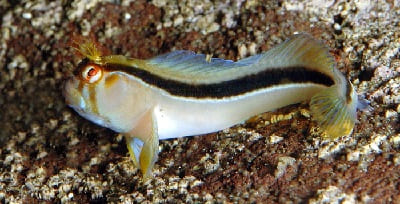Home › Sea Creatures › Marine Animals › Vertebrate › Blennies › Crested Blenny
Interesting Facts about the Crested Blenny
[Phylum: Chordata] [Class: Actinopterygii] [Order: Blenniiformes] [Genus: Parablennius]
The combtooth blenny family contains more than four hundred recognised species and one of them is the crested blenny.
This page contains information about the crested blenny fish (Parablennius laticlavius), including where they live, what they eat, and how they reproduce.
Parablennius laticlavius Range and Habitats
Living inside the crevices of rocky pools and reefs are the typical places to find these small bottom-dwellers.
Even though some blenny fish can survive at depths of 400 metres, the crested blenny only inhabits shallow water environments.
In reality, the optimum place to find them is between one (1) and three (3) metres deep around the intertidal zones of:
- Australia (e.g. off the coast of New South Wales)
- Northern New Zealand (including the Kermadec Islands)
In general, blennies are a hardy fish species and you can find them in most temperate regions - and even in some few cold water ecosystems. Scientists use their fin formation to identify the different groupings.
Blenny fish are mostly a benthic species, spending a lot of time scurrying around the ocean floor. Nonetheless, the sabre-toothed blenny (Aspidontus taeniatus) is known for spending more time 'mid-water' hunting for food.
Crested Blenny Fish Description
Almost all types of blennies fish are reclusive creatures. They make burrows in the sandy substrate (e.g. sand and mud) and they hide inside the crevices of rocky reefs.
In fact, some blenny fish species actually live inside unoccupied shells of large mollusks. Hence, it's not unusual to find a female nesting inside an empty clam shell or oyster shell.
 Most blennies have spiny fins, scaleless skin, and a large blunt head.
Most blennies have spiny fins, scaleless skin, and a large blunt head.
Yet, the main characterisation of the crested blenny fish is the steep sloping forehead.
Here's the thing:
Crested blennies have soft, bristle-like appendages (known as "cirri") on their head.
The elongated dorsal fin has short spines and the pelvic fins are located close to the esophagus (area at the back of the throat). It would be rare for an adult crested blenny fish to grow much longer than eight (8) centimetres (3 inches).
It's likely that these prominent features have a role in sensory perception or for camouflage. But, the dominant colours of the crested blenny fish (Parablennius laticlavius) are pale cream tinged with some yellow and a white underbelly.
They also have a single dark spot behind the eye and a dark stripe (usually purple or black) on the upper flank. This dark band actually extends from the rear of the eyes all the way to the base of the caudal fin.
What Do Blennies Eat?
Most of the blennioid species of fishes are completely carnivorous (e.g. Clinid). But, the herbivorous specimens will display algae-grazing behaviour. This is one reason why people keep blennies in an aquarium. In fact, some of the blenny species are detritivores (e.g. they consume detritus).
Much like the goby fish family, the vast majority of the blennies species eat tiny crustaceans (e.g. Mysida) with a combination of small mollusks and various planktonic organisms.
Courtship Behaviour of Blennies
For the most part, the adult male blenny will grow larger than the female. Plus, they all tend to change their base colouring according to the local habitat.
Colour changing also occurs during the mating season - either through excitement or to make themselves appear more attractive!
Fun Fact: The flame tail blenny (Ecsenius bicolor) is considered as being the 'cutest' because it displays a brown and yellowish orange colouring. This species is seen most often in marine aquariums darting about and generally being a little aggressive with other species.
Related Information and Help Guides
- Interesting Facts about Tube Blennies (Chaenopsidae)
- Gobies Fish Facts and Interesting Information
- Combtooth Blenny Fish Facts and Information (Blenniidae)
- Wrasse Fish Species Interesting Information
- Pholidichthys leucotaenia: Is it a Blenny or a Goby?
Note: The short video [6:47 minutes] presented by 'Aquarium Fish Keepers' explains how to choose the right blenny fish for a pet and then how to take care of it when it's living in a fish tank.